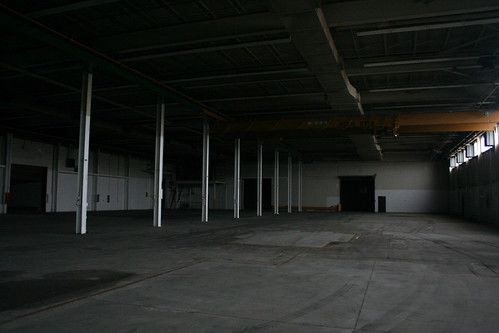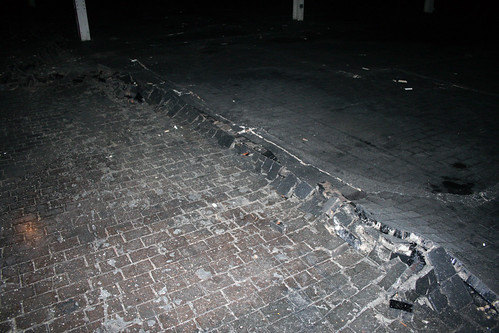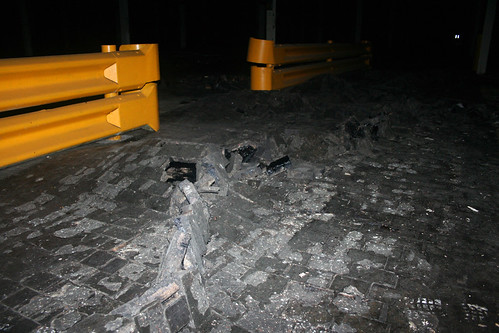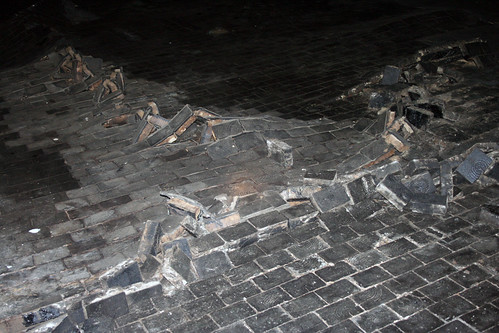Some time ago, I had the opportunity to scout the defunct Grumman airplane factory in Bethpage, Long Island. Once the leading manufacturer of everything from F-14’s to the Apollo Lunar Module, Grumman was bought by a larger company in the 1990’s and moved out of Bethpage. The enormous complex is now being converted into residential and commercial space, with many of the remaining warehouses having been converted into studio space like the one pictured below:
While scouting there recently, I got to see a few of the remaining aircraft factory warehouses. Though they’re completely empty, it was still pretty amazing. Each warehouse is enormous, stretching on for room after room after room.
The below picture gives you a sense of how much space was used for airplane assembly:
Also, when I took my tour, a few of the buildings didn’t have power…
…which was creepy, especially when you realized that some of the floors have sudden significant drops, and a wrong step could send you plummeting:
I can’t remember exactly what this was designed for – I want to say it was for working on the underside of planes, but I feel like the explanation was more clever than that. Anyone know? I seem to recall that these were capable of filling with water.
But what really interested me were the floors, which looked like brick, but were actually made of wooden blocks. Why wood? Because when you drop a 5 ton engine on wooden blocks, they don’t smash into a million pieces.
But here’s the neat thing: As I was taking pictures, I began to notice long lines of uprooted wooden blocks, zigzagging across the floor as if an earthquake had struck:
Turns out, this is a result of the wood expanding due to temperature:
It was pretty amazing how it erupted in linear patterns, stretching on for hundreds of feet across the warehouse floor. I’m curious if it was a gradual uprooting, or a sudden event:
More upturned blocks:
One last tidbit: Grumman was also responsible for designing and building the LLV, or Long Life Vehicle, which you might recognize below:
-SCOUT













Wow…that’s where they built the LEM that saved the Apollo 13 crew. I’m a bit of a nut for early space flight stuff, as much as I am for Coney Island and for cool old buildings.
I once had the occasion to ride around NYC for a couple of days with David Lynch — I was helping to publicize his book on meditation, and was escorting him to interviews, readings, etc. Early on, I started to point out beautiful old buildings and he loved them all too — it was kind of a bonding point for us (and since I’m not in the film industry, it was a rare occasion to spend a teeny bit of quality time with the greatest living American avant-garde movie director).
I love your blog.
There’s a pretty cool air and space museum out there, too.
Wood block flooring is still in use a lot today. It’s good for absorbing spilled industrial lubricants, it has a certain amount of give as you pointed out, and it’s cheap and replenishable, sort of a “green” material. Lots of car factories still use it. I’ve never seen a crack quite like that, but I would guess it might be related to the condition of the subfloor – maybe a seam in the concrete or an expansion joint or something, or just the settling of the building’s foundation.
Grumman used structural steel from demolished NYC elevated subway lines to build their factories and airplanes during World War II.
they also built a lot of the UPS trucks you see around town
I will bet you that those blocks heaved because they got wet. Wood floors hate to get wet, and when they do, they expand, and jump up just like in your picture. Happened in my kitchen once.
I was in the Electro Motive locomotive factory in McCook Ill & it also has a similar wood block floor made up of thousands & thousands of 4x4s on their ends.
All his life, my father was a machinist. Wooden block floors were and probably still are common in machine shops.
Pingback: Flavorwire » What’s on at Flavorpill: Links That Made the Rounds in Our Office
Pingback: Flavorwire » What’s on at Flavorpill: Links That Made the Rounds in Our Office
Grumman merged with Northrop in the 1990s and became Northrop Grumman. Aircraft production moved out of Bethpage even before then, but Grumman didn’t. At least I don’t think they did, because I drive out to Bethpage every day and my ID badge has Northop Grumman printed on it 🙂 Although most of the buildings were sold off, Grumman still uses the building where the LEM was designed.
The buildings you toured are now known as “Grumman Studios” http://grummanstudios.com/
I don’t specifically know about those pools, but they look very similar to those at a place that used to be used up until about 3 year ago for nuclear weaponry.
I have been browsing online more than three hours nowadays, but I by no means found any attention-grabbing article like yours. It is lovely price enough for me. In my opinion, if all web owners and bloggers made good content material as you did, the internet will probably be much more useful than ever before.
Definitely this blog is very informative and neatly designed. Really you’ve motivated me strongly in my new project by this article. As a constant reader of your blog http://www.teamjeacoma.com I want to tell you that your writing skills are superb.
There was an F-14 hydraulic test rig with these massive veri-drives in the floor that powered the F-14 left and right hydraulic systems when the engines were out of the aircraft. A complete aircraft (with wings swept and sans the engines) would be positioned into the building and lots of instrumentation connected to perform various tests. I was a young US Navy engineer working from time to time with counterparts from Grumman on various upgrades to the F-14 hydraulic systems and spent a considerable amount of time in Bethpage (and Calverton) at the Grumman plants.
Depends on which factory you were in, but this would explain the depressions or pits in part of the factory floor.
Hey – according to IMDb, part of The Avengers was filmed here. Any idea what parts of the movie, and where in the old factory? Thanks!
The pools were used for dipping aircraft parts prior to painting.
…and although it is pronounce “lem” it’s spelled LM.
I was part of the facilities group responsible for every square foot of all Grumman properties; all 14 million of them.
Hello Scout,
Understand this is a couple years late to the party, but I am interested in repurposing such wood block floors in a new manufacturing facility. Any leads you can offer will be appreciated.
Mike
Hi Mike –
The company I work for is considering replacing existing wood block flooring in a space we use as a warehouse. Are you still looking?
Pretty cool place and pics…. Unfortunately Grumman was responsible for illegally dumping poisonous chemicals (for example airplane fuel) on their property. Which leached into the ground water and now pollutes ,or is going to pollute, the Bethpage water supply. And is on its way to contaminating Farmingdale and Massapequa’s water supply….its known as the “Grumman Plume”
My Polish grandmother put the armor plate behind each seat with a Polish prayer.
We were friends with a Marine fighter pilot, now deceased, who flew F-4 Wildcats in WW2. He flew off of Fighter One on Guadalcanal, a dirt parallel runway to Henderson Field. A Jap hit his armored seat back with a 20mm round, putting shrapnel in the cockpit and cutting his face, but the armor saved (obviously) his life. If your grandmother is still alive, tell her she saved Col. (then Lt.) Sam Richards’ life in November 1942. Thank you for the great post and thank your grandmother!
My brother in law’s Mom also worked at Grumman during the war and built the F-4’s. Her name was Rose Walbroehl. I wonder if your grandmother knew her?
Van out.
Worked for Grumman about 5-1/2 years. Late 80’s to early 90’s.
The wood block floor pictures do show the affect of the wood absorbing moisture and expanding causing uplifting. Especially when the wood blocks are line up or arranged in tile form as they were. Each block’s expansion applied sideward pressure causing a weaker part of the total floor to uplift.
I still remember the long production lines of E-2C Hawkeyes,A-6’s,
and F-14’s on the plant floors both in Bethpage and Calverton. Especially noting the Guppy landing in Bethpage to pick up a spare space shuttle wing. Much, much history for which I am proud to be part of for the few years I had. Learned alot and good people. Its one of the few companies for which I still have pride for today in 2013. Wish very much things could have continued.
Back in the early 90’s I was fortunate enough to live on Long Island for a couple of years. I would explore and photograph abandoned buildings in my spare time. One day I was in the Fairchild-Republic factory in Farmingdale and the floor was buckled just as you noted.
I was puzzled by it and couldn’t find anyone to explain it. Thanks for the posting! My question is answered 20 years later.
I remember hanging out on South Broadway (107) as a teen in the 1980’s. There were a few occasions, always late at night, that large trucks would roll into Grumman surrounded by a contingent of security vehicles that looked more like army trucks than any typical police. The trucks carried massive objects, with tarps covering them well. Traffic if any, was forced to stop and wait at the side of the road while the convoys would enter the Grumman gates. I caught a tiny glimpse of their payload once. Looked like a large ring. I would imagine a fuselage section, perhaps, or maybe a ring from a rocket section. Always well guarded. Always secret.
My aunt, Grace Scanlon, worked and died at Grumman. She was a 26-year old plane captain and flight observer on the Avenger when a plane being tested on the runway tilted forward and the propellor snapped off. It hit Grace in the back of the head – nearly decapitated her. A newspaper article mentioned that she had endured tremendous danger in the air while helping to test the planes, only to die on the ground. It was 5 Jan 1944. She had chalked on the last Avenger off the line, Mission completed”.on 31 Dec 1943. The words stayed through the final cleaning process and the plane went on to fly many missions. When it was finally shot down, it went so gently the pilot and crew made it to the water and survived.
Wood block industrial flooring is made from end grain wood because it is hard wearing and cut and abrasion resistant. This is the same reason that True butcher blocks are end grain on the surface not long grain. Alot of the really old wood block flooring is oak.
Wood block floors were used because they allowed great flexibility in production line layout. If you needed to add or remove or replace a machine, it was easy. Watch some America Goes to War movies on Youtube and you’ll see guys laying the floor at amazing speed.